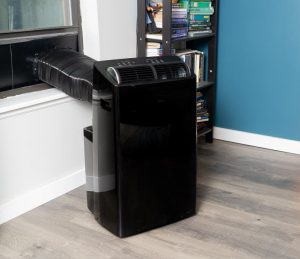
Heat pumps come in all different sizes, from portable and window units, to ducted and ductless whole-house systems, to apartment building-scale underground systems. They come in different “flavors” too, including air to air transfer (air-source), ground to air transfer (thermal or ground-source), and water to air transfer (water-source). What they all have in common is that they run with exceptional efficiency on electricity, and are currently the most climate-friendly way to both heat and cool indoor environments.
Each type of heat pump system has its own distinct set of advantages and disadvantages. Choosing a heat pump system that’s right for you will depend on the size of your home and your local climate, as well as how much control you have over the property.
Portable Solutions
Many friends have asked about heat pumps for apartments and condos, situations where residents often don’t have complete control over their appliance choices. In urban areas, multi-unit residents are the majority. In Los Angeles, for instance, 56% of Angelenos live in multi-unit buildings, and 63% of all residents are renters (per 2020 census). Renters usually have little say in how their units are heated and cooled. But even condo owners are limited in their choices, given HOA guidelines and site limitations which they cannot change on their own. Thus the question: How to heat pump in an apartment or condo?
Often, even if it is physically possible to set up a heat pump system in an apartment or condo, the choice ultimately depends upon the willingness of the landlord or the HOA. Where system installation is not feasible, there are two other air source options: a portable heat pump or a window unit heat pump. (For more on how heat pumps work, and why they’re called heat pumps, see my earlier post, “My Heat Pump Story”.)
Portable heat pumps look and function very much like portable air conditioners, except that they are dual function. That is, they both heat and cool indoor spaces, just like installed heat pump systems. They are freestanding units with hoses attached to window panels.
Portable heat pumps maximize their efficiency when you can benefit from the heat function. The air conditioning function in a portable heat pump is not necessarily more efficient than a new, equivalently-sized portable air conditioner. (Treehugger) The main efficiency gain is with the heat function. So if you have a reliable heating system, a portable heat pump may not be any better for you than a portable AC-only unit.
If you could use supplemental heat, however, a heat pump definitely makes sense as a viable option in apartments and condos. You’ll add the ability to cool interior space, while increasing heating efficiency.
One Room at a Time
Another important fact to consider is that both portable heat pumps and portable air conditioners are set up to heat and/or cool one room. To move them from room to room means removing and reinstalling the window exhaust hose kit. While not particularly complicated, it is not something you would want to do on a daily basis. So if you have one main room that needs cooling and heating, a portable heat pump is a great, climate-friendly option for an apartment or condo. You would have the option to move it if needed (to another room or another unit), and you shouldn’t need approval to set up a portable heat pump.
A Real-Life Case Study
My friends, Jill and Gil, have a portable heat pump in a converted garage which has become their second living room. They needed to add a source of heat since the space is separate from the ducted heating system of the house. So they purchased and set up a portable heat pump, and they’ve been very happy with it.
Living for many years only a mile from the beach in Southern California, Jill and Gil hadn’t needed or wished for air conditioning. But with our warming climate often causing considerably warmer summers, they are really appreciating the option to cool. Their portable heat pump provides both heating and cooling in a room they use quite a lot throughout the year.
One thing Jill noted with their portable heat pump is that they need to periodically empty condensation from the bottom of the heat pump. In a heat pump system like my ductless mini-split, most condensation is routed out of the house through a small pipe (though an annual wall unit cleaning is a good idea). With a portable heat pump, that small task needs to be done by hand. The condensation is a result of one of the best features of heat pumps: they are excellent dehumidifiers.
What to Consider
Portable heat pump prices are generally in the $500-700 range, comparable to high-end portable air conditioners. Prices and availability vary, of course; I’ve seen some on sale, and others out of stock. Sources include the big box stores (Costco, Lowes, Home Depot, Best Buy), Amazon, and manufacturer websites.
Usually they are marketed as a portable air conditioner with heat, or sometimes as a portable air conditioner with heat pump, but generally not as a portable heat pump. I’m sure that companies are trying to make clear that their units include air conditioning, given the confusion the term heat pump can cause. Just make sure that the portable AC unit you are considering includes the heat option if shopping for a portable heat pump.
Another consideration is that there are single-hose or dual-hose portable heat pumps on the market. The two pump system is more energy efficient, but not significantly. Opinion is split as to the advantage of a single- vs dual-hose option. The only time that a dual-hose is absolutely recommended is when there is a gas appliance such as a furnace or hot water heater in the same room, not likely except in a finished basement, due to the slight vacuum effect created with the single-hose option. (For more information, check out the Wirecutter and Cielo site pages linked here.) For most rooms, a single-hose unit is fine, and less intrusive with one less hose.
Recommendations
My friend Jill recommends the portable heat pump that they purchased two years ago: a single-hose DeLonghi Pinguino (PAC EL375HGRKC-3AL) which she and Gil are very happy with. There are numerous other manufacturers now offering portable heat pumps, including Honeywell, Frigidaire, Whynter, etc.
The New York Times’ Wirecutter product review section recently recommended a portable heat pump as the top pick in their June 2023 portable air conditioner reviews: the dual-hose Midea Duo MAP14HS1TBL (see photo above). They describe their recommended model as quieter and more efficient than the portable air conditioner-only models they also tested for the article. The Midea Duo can also be set to maintain a steady temperature by shifting between cooling and heating, if needed.
One last caveat before purchasing…While portable heat pumps have adaptable window kits, make sure that the size range for your proposed unit fits the window dimensions you have available. As they all come with several window kit options, this should not be an issue for most buyers.
Window Heat Pumps
As mentioned above, there are also window unit heat pumps available. If an apartment or condo already has a window air conditioner installed, it should be fairly easy to replace it with a more efficient and quieter heat pump unit. They are basically the same size, and are installed in the same way as an AC only window unit. Window unit heat pumps lack the advantage of true portability, but they could be a good option for many. I have not found as much information on this option, but functionally they work like the portable heat pumps I have focused on. Most window heat pumps are priced in the same range as standard window air conditioners. One new window heat pump technology from Gradient is quite impressive in both features and function, but it is also very expensive. If any readers have any information to share on Window Heat Pumps, let me know with a comment below!
Options for Everyone
There are heat pump options for everyone, and new variations in the works! Efficient heating and cooling without direct fossil fuel emissions is possible in every home, whether a studio apartment or a sprawling mansion. Of course, heat pumps can be adapted to most any building function, from industrial to business to public spaces, but in this series I focus on residential options. Come back soon for another installment!
Sources
Treehugger – What Are Portable Heat Pumps
The New York Times Wirecutter – The Best Portable Air Conditioners
Cielo – Are Portable Heat Pumps an Excellent Choice for Your Heating and Cooling?
Photo Credit: Michael Hession



2 Responses
Maybe you can include photos of what the units look like…
The banner photo and the blog link photo on the main and blog pages show a portable heat pump. But I can see that the banner photo doesn’t show the unit very well at all! I’ve just added a photo to the post…thanks for the suggestion:)